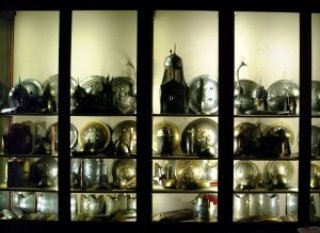
The Girasoli (Sunflower) System was installed in the Islamic Room of the Stibbert Museum in Florence.
In the Hall of the Museum there are two showcases connected with the Sunflowers. Each Sunflower includes solar collectors each of which is coupled with a bundle of fibers. The fibers carry the light inside the display cases, each termination is a light point. The application for museum lighting, and in particular for the lighting of metal objects, required specific studies to obtain particular color shades of light.
An alternative lighting system was also created, to be used in the absence of the sun, which uses a new type of LED (Light Emitting Diodes) with white light and low energy consumption.
Lighting in museums has some basic requirements:
The quality of the light and the color balance of the two types of lighting was examined with photometric and colorimetric measurements. Based on these measurements, the necessary filters for fibers and LEDs were defined. The result, obtained in agreement with the museum experts, is a yellow-orange light.
Solar lighting is activated when a visitor is in the room, obviously on a sunny day. In case of absence of sun, the alternative lighting is activated, which uses white light and low consumption LEDs.
In general, the level of illuminance for the windows of the Islamic Room was indicated between 100-120 lux on average. This value takes into account the lighting levels indicated by the ICOM (International Council Of Museum), shown in the table below, considering that the objects on display are mainly metal: weapons, chain mail ...
The table shows that the objects more delicate such as clothes or fabrics in general, they must not be
exposed to lighting above 50 lux
| Objects | Recommended Illuminance |
| Metals, stone, ceramic, enamel, most minerals. | No limits |
| Paint and oil paintings, frescoes, uncolored leather, bones, uncolored wood and lacquer, some plastics. |
150 Lux |
| Textile fibers, clothes, tapestries, inscriptions on paper or parchment, colored leather and wood, botanical species, furs and feathers. | 50 Lux |
The two types of lighting were estimated and measured separately directly inside the showcases during the tests to identify the best arrangement of the respective light points.
The final arrangement of the fibers and the LEDs satisfies the requirement of uniform illumination and light equivalence between the two types.
It was decided to arrange the fibers and the LEDs on the inner edge of each window door.


CNR-INO Istituto Nazionale di Ottica - Largo Fermi 6, 50125 Firenze - Tel. +39 05523081 - P.iva 02118311006 - Info: info@ino.cnr.it